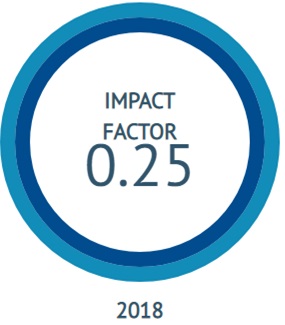Synthetic C-Methoxyphenyl Calix [4] Resorcinarene and Its Antioxidant Activity
Abstract
C-methoxy calix[4]resorcinarene macromolecule is one of calysarene group compounds.The calysarene compounds have been reported to have any beneficial functions in various applications in medical field, such as an adsorbent for sunscreen and heavy metal, anti-HIV and HCV, and anti tumour. The C-methoxyphenyl calix[4]resorcinarene (CMPCR) is one of the C-methoxy calix [4] resorcinarene derivatives, in which researches in application of C-methoxy calix[4]resorcinarene itself in the medical field is rarely conducted. In present study, the researcher attempted to synthesize the CMPCR compound and followed by charaterizations of the synthetic compound resulted using infrared spectrophotometer instrument, proton nuclear magnetic resonance (H-NMR), and carbon-nuclear magnetic resonance (C-NMR) methods to ensure that the product is CMPCR compound. The yielded compound was further tested to recognize its antioxidant activity. The antioxidant testing required is in line with the increases of diseases caused by over concentration of the free radicals existing in biocellular system. The CMPCR synthesis was performed by condensation and antioxidant activity was tested using 1,1-diphenyl-2-picrylhydrazyl (DPPH) methods. Results showed that the reaction product was white precipitate with 390 oC melting point and the reaction yield was 97.05%. The antioxidant activity showed that its IC50 value equal to 79 ppm. Comparing to the vitamin C which has IC50 equal to 20.96 ppm, the CMPCR compound-the synthetic product, has level qualification of antioxidant activity equal to strong (IC50 <100).
Keywords: activity, antioxidant, calix[4]resorcinarene, characterization
Downloads
References
2. Do QD, Angkawijaya AE, Tran-Nguyen PL, et al. Effect of extraction solvent on total phenol content, total flavonoid content, and antioxidant activity of Limnophila aromatica. J. 2014;22(3):296-302. DOI:10.1016/j.jfda.2013.11.001
3. Khodr B, Khalil Z. Modulation of inflammation by reactive oxygen species: implications for aging and tissue repair. F. 2001;30(1):1-8. DOI:10.1016/s0891-5849(00)00378-6
4. Koleva II, van Beek TA, Linssen JPH, Groot A de, Evstatieva LN. Screening of Plant Extracts for Antioxidant Activity: a Comparative Study on Three Testing Methods. P. 2002;13(1):8-17. DOI:10.1002/pca.611
5. Musialik M, Litwinienko G. Scavenging of dpph•Radicals by Vitamin E Is Accelerated by Its Partial Ionization: the Role of Sequential Proton Loss Electron Transfer. O. 2005;7(22):4951-4954. DOI:10.1021/ol051962j
6. Shinkai S, Kohno H, Kimura K, et al. Physical activity and immune senescence in men. Med Sci Sports Exerc. 1995;27(11):1516-1526.
7. Tsou LK, Dutschman GE, Gullen EA, Telpoukhovskaia M, Cheng Y-C, Hamilton AD. Discovery of a synthetic dual inhibitor of HIV and HCV infection based on a tetrabutoxy-calix[4]arene scaffold. B. 2010;20(7):2137-2139. DOI:10.1016/j.bmcl.2010.02.043
8. Yohanes B, Nagao K, Yanagita T. Shochu Kasu against Fatty Liver Disease: The Therapeutic Properties from Basic Science to Clinical Practice. Germany: LAP LAMBERT Academic Publishing; 2011.
Copyright (c) 2018 Journal of Applied Chemical Sciences

This work is licensed under a Creative Commons Attribution-NonCommercial-ShareAlike 4.0 International License.

 Budiana I Gusti M. Ngurah(1*)
Budiana I Gusti M. Ngurah(1*)










